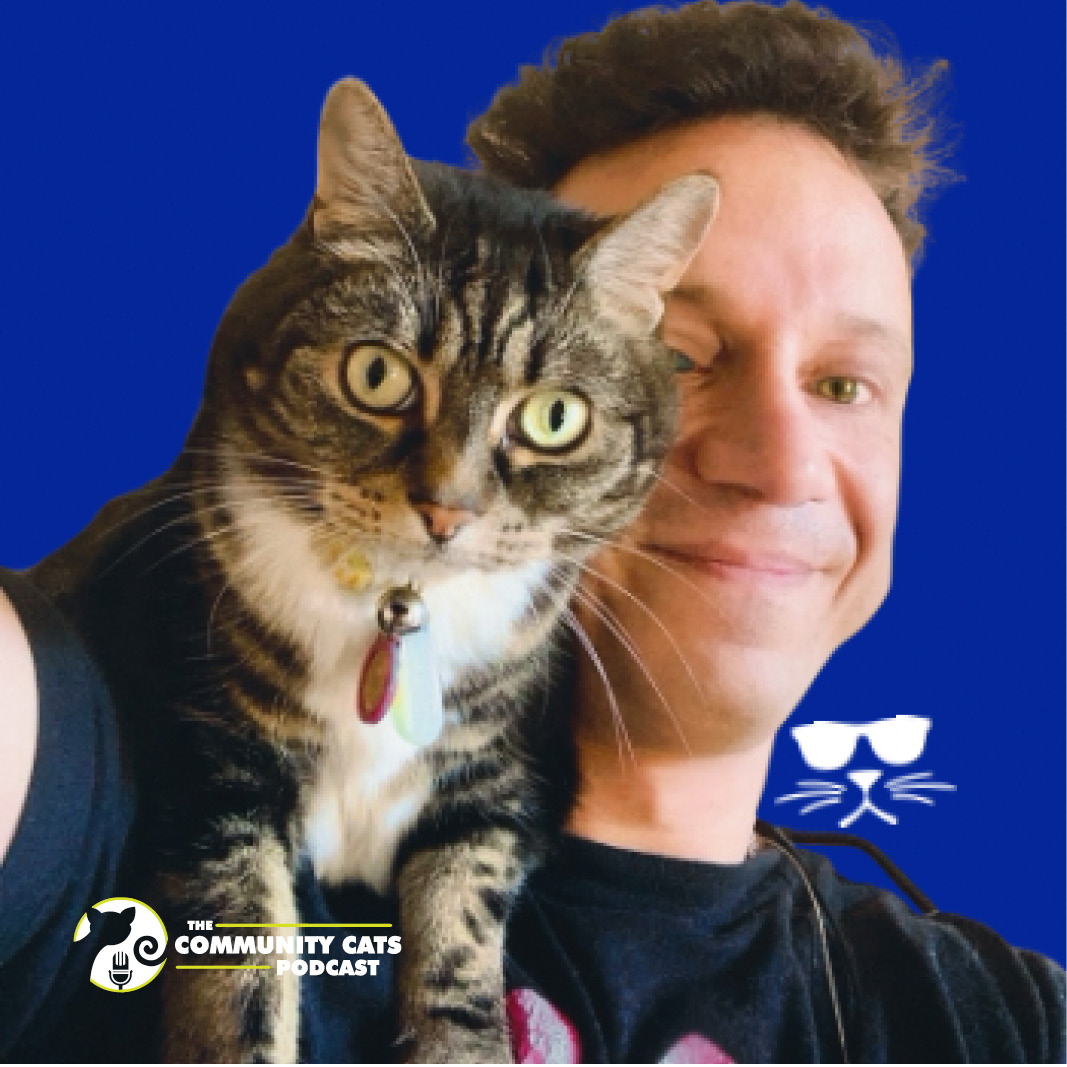
Picking, Protecting, and Pampering Cats with Justin Donne, Founder of The Kitty Boss
June 27, 2023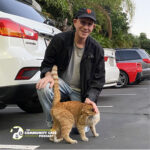
Mobilizing the Community to Make TNR Happen, Part 1, with Bryan Kortis, National Programs Director for Neighborhood Cats
July 4, 2023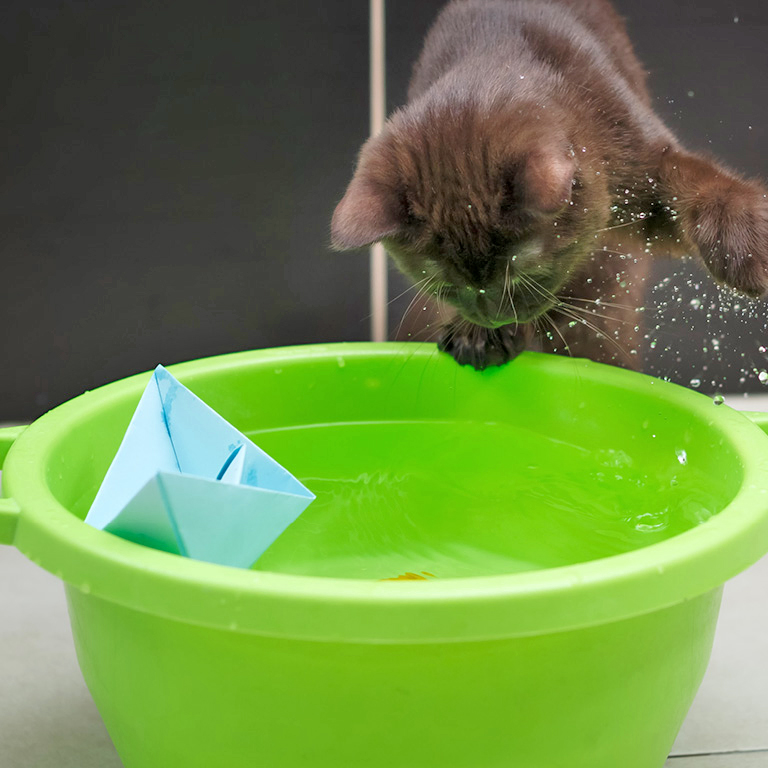
Contributed by Allison Hunter-Frederick, Certified Cat Behavior Consultant and Trainer, Allison Helps Cats
Thinking of new ways to enrich the lives of our cats is a fun part of being a cat owner. Enrichment is also good for our cats. It provides them with opportunities to express species-appropriate behavior, which helps stimulate their minds and bodies, making for healthier and happier cats. In this article, I’ll cover low-cost ways to offer environmental, sensory, physical, and cognitive enrichment.
Environmental Enrichment
The most basic and well-known type of enrichment is environmental. You can accommodate your cat’s natural hunting instincts by offering food in puzzle feeders. An elevated water dish or fountain might increase your cat’s water intake.
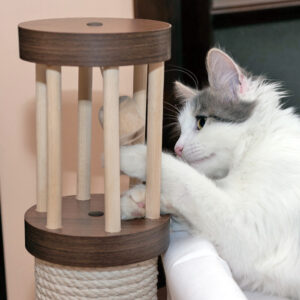 Cats chew because the texture feels good. It also improves their dental health. One way to meet your cats’ chewing needs is to provide them with cat chew sticks and toys. The best options will provide a safe and non-destructive outlet for your cat’s urge to chew.
Cats chew because the texture feels good. It also improves their dental health. One way to meet your cats’ chewing needs is to provide them with cat chew sticks and toys. The best options will provide a safe and non-destructive outlet for your cat’s urge to chew.
By instinct, cats need to hide and climb. Studies show that you can best meet these needs with boxes and cat condos. Hiding under furniture is a sign of an insecure cat. Ample vertical space should be provided instead to meet your cat’s need to observe the world and escape stressors.
The best way to provide cats with a scratching option is through a scratching post. Most cats like to scratch vertically on a sturdy post that is taller than their body length so they can fully stretch. If your cat is scratching your carpet, try a horizontal scratching option instead. Sisal allows cats to dig their claws in and get an effective scratch, but some cats prefer cardboard, carpet, cloth, or wood. Scratching options should be placed near preferred resting places in socially significant areas.
Other types of environmental enrichment include newspaper tents, cardboard castles, window ledges, and night lights. The latter is especially useful for older cats. If you’re handy, which I’m not, some pet owners have affixed carpet scraps to their walls to create climbing walls for their cats.
Sensory Enrichment
Sensory enrichment refers to any activity that positively stimulates a cat’s senses. Natural forms of visual enrichment include fish tanks, bird and squirrel feeders, and leaving the outside light on at night to attract insects. Less natural forms include cat apps, blowing soap bubbles, and nature videos. Additional options for shelter cats include ceiling mobiles, disco balls, liquid timer toys, and perpetual motion toys.
The most natural forms of auditory enrichment include your voice and outdoor sounds. You should minimize exposure or desensitize cats to harsh human-related sounds. Less natural forms include species-specific music and recordings of nature.
The most popular forms of olfactory enrichment include catnip, grass, and silver vine. A scent board can be created out of an art pallet where each section is used for a different smell, or you could opt for a sensory variety package from spacekittyexpress.com. Olfactory enrichment can also come from your kitchen. A pinch of a dried cat-friendly spice can be placed on a cloth for your cat to smell. Some safe options include basil, cilantro, dill, frankincense, parsley, rosemary, sage, and thyme.
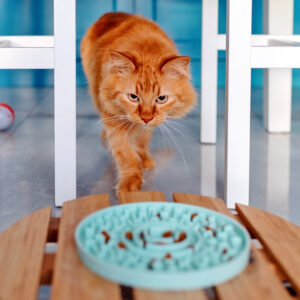 The ultimate way to provide gustatory enrichment is through a puzzle feeder. You can make your own with cardboard toilet paper and paper towel tubes, egg cartons, ice-cube trays, or muffin pans. If you want a commercial version, check out foodpuzzlesforcats.com. You can also simply hide treats around a room to satisfy your cat’s hunting instinct.
The ultimate way to provide gustatory enrichment is through a puzzle feeder. You can make your own with cardboard toilet paper and paper towel tubes, egg cartons, ice-cube trays, or muffin pans. If you want a commercial version, check out foodpuzzlesforcats.com. You can also simply hide treats around a room to satisfy your cat’s hunting instinct.
Natural forms of tactile enrichment include cat-friendly outdoor items such as bark and leaves. Outdoor items should be free of herbicides and insects. A tactile board with different textures attached can be created for your cat to feel. You can also buy peacock feathers. Options for working with reclusive shelter cats include back-scratchers, chopsticks, and paint brushes to gently stroke a cat.
Physical Enrichment
Physical enrichment helps cats maintain a healthy weight and stimulates their bodies. The ultimate type of physical enrichment is play. Some affordable commercial options are plush mice, crinkle balls, plastic springs, and wand toys. In addition, larger toys make good kick toys for cats who kick an object with their hind legs, the way they would kick prey in the wild.
Wand toys are the best at emulating the entire hunting sequence (stare-stalk-pounce-catch) and being interactive. Studies have shown that wand toys are favored among cats. Timid cats might initially find them scary but tend to respond well to wand toys being dragged under a rug. Active cats enjoy racing after them and jumping onto high surfaces to catch them.
With all toys, you should evaluate whether they’re safe. Catster posted four selection guidelines for cat toys. At the top of the list is to select toys that your cat can’t swallow, which rules out many household items that cats like. Its second and third guidelines are to choose toys that can’t be taken apart by cat teeth and/or claws and to choose toys that don’t have pieces that can cut, scrape, or poke cats. While Catster didn’t frown upon the use of wand toys, it said to monitor them because of their potential strangulation hazards.
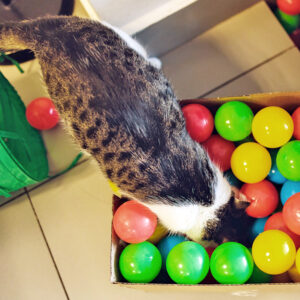 Other types of physical enrichment include forage boxes, “hockey rinks,” obstacle courses, and supervised outings. Forage boxes allow the option of putting not just treats but also toys into holes for a cat to dig out. Cat Amazing will send one of its free forage boxes to a rescue or shelter upon request. Hockey rinks can be created with a box and balls. Obstacle courses can be created by using furniture and pillows to create jumping surfaces and tunnels.
Other types of physical enrichment include forage boxes, “hockey rinks,” obstacle courses, and supervised outings. Forage boxes allow the option of putting not just treats but also toys into holes for a cat to dig out. Cat Amazing will send one of its free forage boxes to a rescue or shelter upon request. Hockey rinks can be created with a box and balls. Obstacle courses can be created by using furniture and pillows to create jumping surfaces and tunnels.
Cognitive Enrichment
Cognitive enrichment helps cats work their brains and keeps them from getting bored. My long-time favorite form of cognitive enrichment is training. Some training options include teaching them manners such as sit, come, stay, and leave it. You could also teach your cat tricks. To do this, try starting with target training and then use that to teach skills such as high-five, twirling, and weaving. For manners and tricks, I’d suggest starting with the Cat School YouTube account.
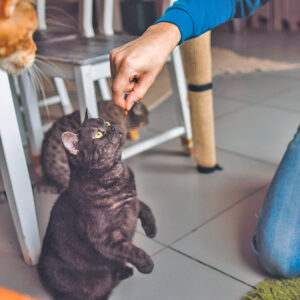 A newer training option I’m exploring is nose work, a training activity in which your cat is seeking, sniffing, and hunting for treats. You can find out more at noseworkcats.com.
A newer training option I’m exploring is nose work, a training activity in which your cat is seeking, sniffing, and hunting for treats. You can find out more at noseworkcats.com.
Finally, there is cat agility, a sport where you direct your cat through a pre-set obstacle course that could include jumps, tunnels, catwalks, A-frames, and weaves.
Other types of cognitive enrichment include: Guess the Cup, fetch, Hide and Seek, and Old Things New.
- To play Guess the Cup, place a piece of kibble under one of two cups in front of your cat. Then move the cups around and see if your cat can guess which cup the kibble is under.
- To play Hide and Seek, stand at a short distance and call to your cat. Each time you repeat, move further out of sight. It helps to have treats in hand!
- To play Old Things New, rearrange your cat’s resources. This is best played with a young and confident cat that won’t object to having to find its resources.
As you can see, enriching your cat’s life can be done in a variety of ways without a huge cost.
About Allison Hunter-Frederick
Allison Hunter-Frederick is a certified cat behavior consultant and trainer. She is also a mother of three furkids and several revolving foster cats, a host mom to an international student, and the wife of a supportive husband. Allison is a member of the International Association of Animal Behavior Consultants, Pet Professional Guild (including the PPG Cat Committee), and Best Friends Network Partners. Currently, she volunteers with The Capital Humane Society, The Cat House, Lincoln Animal Ambassadors, and Love on a Leash.




